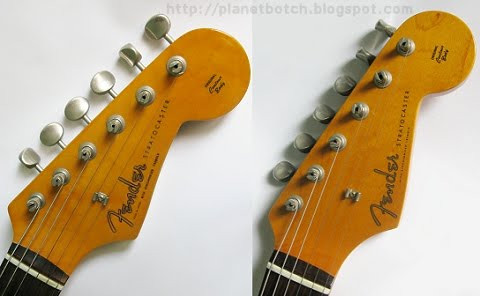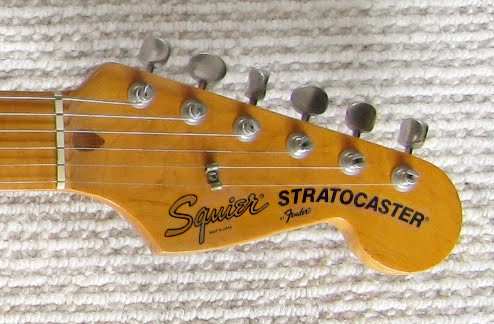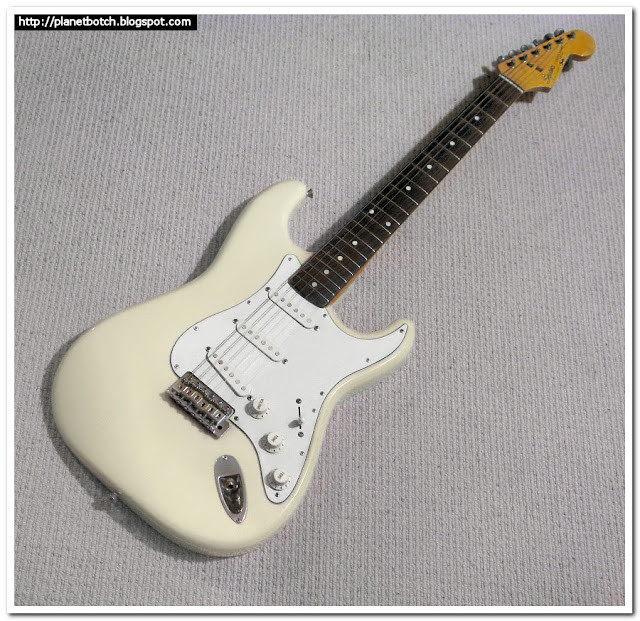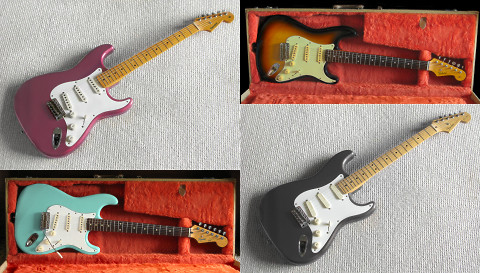The mystique surrounding Strats Guitar from the 1980s, particularly Squier models, often leads to inflated claims and conflicting information. As a dedicated resource for guitar players at guitarplayers.net, we aim to cut through the hype and provide a balanced, expert perspective. While early ’80s Japanese ‘JV Series’ Squier Stratocasters earned a deserved reputation for exceptional value, it’s crucial to understand that not all Squier Strats from this decade are created equal. Some vendors, in their enthusiasm to make a sale, may exaggerate the quality of later ’80s Squiers, misrepresenting them based on the glowing reputation of the best JV models. This guide serves to offer clarity, offering an impartial exploration of the 1980s Squier Stratocaster landscape – encompassing both the gems and the guitars that might not live up to the legend.
It’s important to note that this article focuses primarily on Japanese-made Squier Strats of the 1980s. Korean-made Squiers from the late ’80s, while part of the broader Squier story, represent a different chapter and are not the focus here. Those interested in learning more about the Korean models can find detailed information in our companion piece, “The Truth About… Early Korean Squier Strats“. Similarly, for those seeking information on Fender-branded ’62 Reissue Strats and ’57 Reissues exported from Japan during the mid-80s to mid-90s (FujiGen Gakki Fender MIJs), we have dedicated articles available: ’62 Reissue Strats and ’57 Reissue Strats. Furthermore, enthusiasts of the Squier Japan Silver Series Strats from the early to mid-’90s can explore our in-depth analysis: ’92 Squier Silver Series Strat.
The Genesis of Squier Strats: Fender’s Japanese Venture
For many guitarists, the Squier name is synonymous with Fender’s budget-friendly line. Originally, however, Squier guitars, exclusively made in Japan, were conceived as a means for Fender to compete with the burgeoning market of high-quality, unauthorized guitar copies that were significantly impacting Fender’s profitability. The Squier brand allowed Fender to offer vintage reissue guitars at competitive prices without diluting the prestige of their American-made instruments. Over time, the Squier brand’s role evolved, becoming Fender’s platform for its more affordable, entry-level offerings. Let’s delve deeper into the story of the Japanese Squier Stratocaster.
Premium Beginnings: The JV Series Era
The first strats guitar produced by Fender in Japan were meticulously crafted vintage reissues of the iconic ’57 and ’62 Stratocaster models. Launched in Tokyo in May 1982, this new line, manufactured by FujiGen Gakki, bore serial numbers starting with ‘JV,’ hence the moniker ‘JV Series.’ From the outset, the JV series encompassed various models catering to different price points. These variations included finish types (polyester or nitro-cellulose), body woods, and neck profiles. Notably, early JV series guitars were equipped with sought-after USA-made pickups, a key factor in their revered status. While some components like scratchplates could vary between American and Japanese depending on the model’s price tier, the commitment to quality was evident.
Initially, JV series Strats destined for the Japanese domestic market proudly displayed full Fender branding – the classic ‘spaghetti’ logo on the headstock, with no mention of Squier. These headstocks closely resembled American vintage reissues, distinguished only by ‘Made in Japan’ beneath the Fender logo and a slightly bolder ‘With Synchronized Tremolo’ text. Even the ‘spaghetti’ logo itself was a touch thicker than on later export MIJ models.
 Fender Japan headstock comparison
Fender Japan headstock comparison
For export models shipped to Europe, a subtle but significant change occurred. The ‘Original Contour Body’ text on the headstock was replaced with a black ‘Squier series’ logo. This logo, while larger than the original text, remained smaller than the prominent Fender ‘spaghetti’ logo which was retained. These export-only models, still boasting American pickups and authentic vintage-style cloth wiring, marked the very first appearance of the Squier brand on Stratocasters. Exclusively ’57 or ’62 reissues, these ‘Squier series’ adorned strats guitar were exported starting in spring 1982 for a limited period, notably excluding the USA market. It’s estimated that only around 3,000 instruments in total (across all models, not just Strats) featured this ‘Squier series’ designation on the headstock.
This scarcity makes JV Squier Strats with the Fender ‘spaghetti’ logo and ‘Squier series’ marking exceptionally collectible, particularly those in good condition. These represent the rarest and most sought-after of all Squier Stratocasters.
By summer 1982, the Squier headstock branding underwent a complete revision. The primary logo now read ‘Squier’ in gold ‘transition’ lettering, accompanied by ‘Stratocaster’ in the large, 1970s-style script, and a diminutive ‘by Fender’ logo underneath. Despite the logo changes, these guitars continued to adhere to the ’57 and ’62 vintage reissue specifications. Crucially, there was no inherent quality difference between these models and the initial export run with the ‘Squier series’ augmentation. The primary driver for collectors’ preference for the ‘spaghetti’ logo Squiers is simply their extreme rarity.
In October 1982, Fender introduced a range of Squier-branded Strats specifically for the Japanese domestic market. This marked a turning point, introducing greater complexity to the Squier Strat story. These Japanese domestic Squier reissues, while still part of the JV series, differed from their export counterparts by featuring Japanese-made pickups instead of American ones. This change resulted in significantly lower prices compared to the top-tier, Fender-branded JV models sold domestically. For instance, the premium ST’57-115 ’57 reissue cost Y115,000 in Japan, while the SST-45 ’57 reissue was priced at only Y45,000 – a price difference of more than two and a half times! This price disparity extended across other ’57 reissue models as well. Therefore, generalizations about the quality of all JV series guitars are inaccurate. Material quality and overall guitar specifications varied significantly across the JV range, directly reflected in their price points and product codes.
Export models, including those reaching the UK, occupied a high-spec tier, though not the absolute top of the range. Prices in England typically ranged from £195 to £220, varying slightly depending on the specific guitar and retailer. In terms of component quality for the price, these early export Squiers represented an unprecedented value proposition in Fender’s history. However, the actual playability and sound were less consistent. Contemporary opinions in the ’80s characterized early Squiers as somewhat erratic – some were exceptional, while others were notably inferior, especially when compared to copies from competitors like Tokai. Tokai’s TST-60 Strat copy was considered a direct competitor in specifications to the Squier export models, yet often slightly more affordable and, in many players’ experiences, more consistent in build quality and tone. The author recalls facing a direct choice between Tokai and Squier in 1984, ultimately opting for a Tokai. While early Squiers now appear to be incredibly valuable in retrospect, they faced significant competition and were not always the clear winners in their day.
The Diversification of Squier Strats: Beyond Vintage Reissues
As the Squier range evolved, some less desirable features began to appear, even within the early models. The SST-30 Strat model from 1983, intended for the Japanese domestic market, exemplified this trend. It featured budget-oriented pickups with non-magnetic poles and a ceramic bar glued to the bottom – a characteristic more commonly associated with later, lower-tier Squiers. This inclusion of cheaper components, even in an ’83 model, serves as a reminder that not every JV series Squier Stratocaster automatically equates to a high-quality instrument. While SST-30s were not intended for export, guitars can circulate globally, emphasizing the importance of careful assessment. The key takeaway is to avoid assumptions about blanket quality across all JV series Squier Strats.
A Hint of Diversity: The Current/Popular Stratocaster
Around early 1983, with the introduction of the Squier Current/Popular Stratocaster (model CST-50), Squier began to deviate from strictly adhering to the ’57 and ’62 reissue formula. Despite its name, the Current Stratocaster was essentially a mid-’70s style reissue, featuring ’70s-era specifications like a bullet truss rod and flush-pole pickups. While included in the JV serial number series for the Japanese market, it was exported under a new ‘SQ’ series serial number, marking the beginning of the SQ series outside Japan. The CST-50 further illustrates the variable desirability within early Squiers, as its ’70s-style features mirrored a less favored period in Stratocaster design – incorporating elements like a three-bolt neck tilt and a heavier body.
Navigating the world of early Squiers requires meticulous examination of every detail to determine: a) whether it was a ‘premium’ model initially, b) if it was a well-executed example rather than hastily assembled, and c) if it remains in its original condition, free from part swaps. The author’s own JV ’57 Strat reissue, purchased secondhand in 1993, serves as a case study. While lacking a model number sticker, its features aligned with an ST’57-85 – a cellulose-finished ’57 reissue with an alder body and US pickups (specifically, less common flush-pole alnico pickups). However, despite these promising specifications, the guitar had shortcomings. The neck profile was uncomfortable, the body wood sounded harsh, and the pickups, while good, were not historically accurate for a ’57 Strat, representing a somewhat hybrid ’70s/’60s design. Furthermore, a significant flaw was discovered with the scratchplate mounting, causing the bridge pickup to physically touch the bridge side of the pickup cavity, resulting in a skewed pickup that could not be properly adjusted. This personal experience highlights that even models with seemingly desirable features on paper could fall short in reality. The author sold this Strat in 1994 without regret.
The Second Wave: Contemporary Series and the Rise of Superstrats
Towards the end of 1983, the trend towards diversification culminated in the introduction of the Contemporary Series, a broad range of new strats guitar models. The early 1980s witnessed a surge in popularity for customized Strats among rock guitarists. Players sought Strats equipped with humbucking pickups and aftermarket locking tremolo systems from brands like Floyd Rose and Kahler. Fender Japan responded decisively, venturing into the ‘Superstrat’ realm as 1984 approached. They offered a spectrum of configurations, from classic-style Strats with vibratos and perhaps a single humbucker, to full-fledged metal-oriented machines featuring locking tremolos and multiple humbuckers. Notably, Fender offered both Squier-branded and Fender-branded models within the Contemporary Series for the export market. These Contemporary Series guitars marked the debut of true Fender MIJ models in the UK, without any Squier branding whatsoever.
A significant price gap existed between MIJ Fender Contemporary and Squier Contemporary models. In the UK, Fender versions typically commanded a 50% price premium over their Squier counterparts. Coupled with higher-end hardware, this pricing placed MIJ Fender Contemporaries above regular early ’80s USA models, which were nearing the end of their production run as the Contemporary Series emerged. Brand prestige accounted for a portion of the price difference between Fender MIJ and Squier models.
Despite the branding distinctions, all Contemporary Series guitars shared common traits: high-quality polyester finishes, solid wood construction, and generally excellent build quality, regardless of whether they were branded Squier or Fender. The author observed that Squier versions of these Strats exhibited more consistent build quality than the earlier JV series. However, a key difference lay in the pickups. Squier Contemporary strats guitar typically featured ceramic-bar pickups with non-magnetized poles, considered inferior, while Fender MIJ equivalents were equipped with alnico V pickups. It’s important to note that Squier Contemporaries, while more affordable than the Fender-branded versions, were not necessarily inexpensive. The inclusion of ‘custom’ hardware could elevate their prices considerably.
The author recalls seeking a Contemporary Strat in late 1986 onwards, noting that the Squier System 1 model often approached £300 in price. Considering that the System 1 tremolo was Fender’s most basic locking system and these guitars had budget-oriented pickups and electronics, it’s plausible that Fender achieved higher profit margins on these Squiers compared to the earlier JV models.
The author eventually acquired a System 1 Strat in late 1987, a time when the arrival of Korean Squier Strats had begun to depress prices on the remaining Japanese models. The System 1 Strat’s price dropped from £285 to around £225 as Korean models entered the market at £179 or even £169, effectively undercutting the Japanese range. Despite this price adjustment, the build quality and finish of these final Japanese Squiers remained exceptionally high. While electrical components and body wood quality were inferior compared to early JV guitars, the Contemporary series Squiers, as mentioned, seemed to exhibit greater consistency in assembly.
Once the Contemporary Series proved successful in carrying the Squier brand, the JV series was discontinued. Fender likely sought a way out of the low-profit vintage reissue market. With Squier establishing itself as a reputable brand, the strategic shift was to move away from direct competition with brands like Tokai and Fernandes in the vintage reissue space and focus on more profitable market segments.
The photograph below illustrates a typical mid-1980s Squier Stratocaster after the JV series era. While still resembling a vintage ’62 reissue in overall styling, and even featuring headstock markings closer to ’60s styles than the JV Squiers’ large-print logos, key differences are apparent. The electrics were noticeably downgraded, featuring plastic wiring instead of cloth, and the pickups were ceramic with non-staggered flush poles – a clear indicator of cost-saving measures. Another detail is the presence of two string guides on the headstock, unlike the single guide found on a JV ’62 reissue. Despite these deviations, Fender continued to market these guitars as ’57 and ’62 reissues, even as late as August 1986, according to “Making Music” magazine. The full recommended retail price for these ‘reissues’ in the UK had reached £272 by this time.
The Contemporary Series flourished throughout the mid-1980s, encompassing a bewildering array of features to cater to diverse budgets and player preferences. These instruments were integrated into the standard Fender ‘E’ serial number series (‘E’ for ‘eighties’), which continued into the initial Korean-made guitars.
Detailing every nuance of this production phase is impractical, but some important generalizations can be made. Until 1987, all Squier Strats were manufactured in Japan. After 1984, no model could be considered a truly accurate vintage reissue, despite Fender’s continued designations. However, aside from their electronics and high-gloss polyester finishes, the ’57 and ’62 models still retained visual similarities to vintage designs. All post-JV series 1980s Japanese Squier Strats featured solid wood bodies and polyester finishes. It’s crucial to reiterate that electrical components and pickups were generally of lower quality compared to the standard MIJ Fender offerings of the era.
Conclusion: Navigating the 80s Squier Strat Landscape
Ultimately, evaluating a 1980s Squier strats guitar requires relying on your own judgment and discernment. Everything is relative. Compared to a plywood-bodied Korean Squier, a mid-’80s solid-body Japanese Squier is undeniably superior. However, when contrasted with the best export-only Squier ’62 reissues from 1982, that same mid-’80s model becomes significantly less desirable. The author expresses a preference for the early Fender-branded MIJ export reissues from the mid-’80s over the JV Squiers, finding them more consistent and subjectively more appealing, despite being less accurate vintage reissues. In conclusion, remember that not all early Squiers are created equal. While detailed analysis is valuable, your personal impression and evaluation of a specific guitar are paramount. Judge each guitar on its own merits, rather than solely based on hype or generalizations.
Explore More Squier Guitar Articles
Passionate about Strats? Discover a wealth of informative Stratocaster articles on our site, accessible through the Making Music page. Detailed articles for the guitars featured in the composite image above (clockwise from top left) can be found at these links: Fernandes RST50 ‘Revival’, 1980s Tokai TST50 Goldstar, Original ’92 Squier Silver Series Strat, and Original ’87 Eric Clapton Strat. This is just a glimpse into our extensive collection of resources.
Explore More Guitar Reviews and Retrospectives

 Squier JV Strat headstock
Squier JV Strat headstock Squier JV
Squier JV Squier Japan Strat 1985
Squier Japan Strat 1985 Stratocasters
Stratocasters